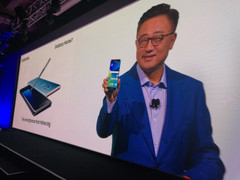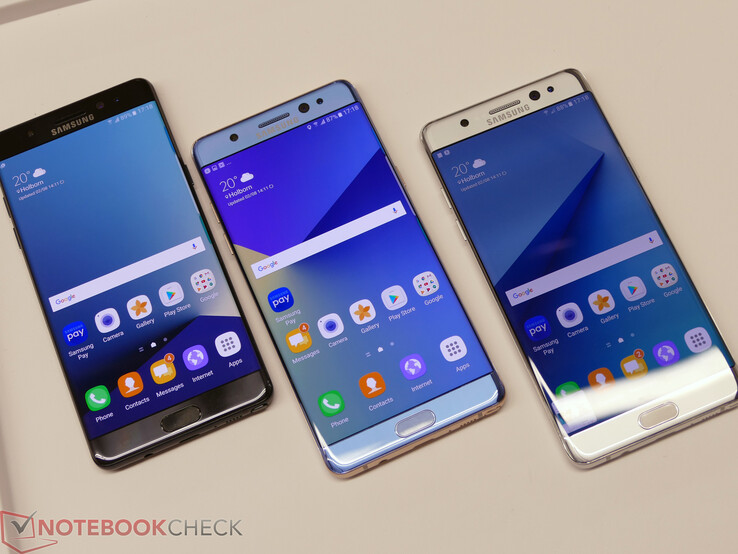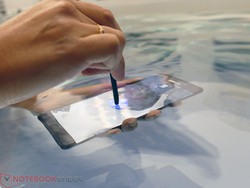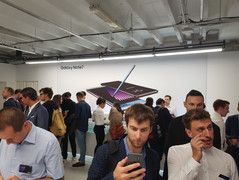Auf 5 folgt die 7. Mit dem aktuellen Samsung Galaxy Note 7 zieht man bei der Produktbezeichnung gleich mit den Smartphone-Boliden Galaxy S7 und S7 Edge (jeweils hier im Test bei Notebookcheck), und will so Verwechslungen und Unsicherheiten über die jeweils aktuellste Generation vorbeugen. Vergleichsweise sicher klangen die Gerüchte der letzten Tage über die finalen Spezifikationen des Edge 7, sickerten doch viele deckungsgleiche Informationen über verschiedenste Quellen ins Netz. Mit dem heutigen Tag der offiziellen Ankündigung werden diese überwiegend bestätigt. Zu den Eckdaten des Hosentaschen-Allrounders:
Display: 5,7 Zoll Super AMOLED Edge
Bei der Displaygröße gibt es keine Veränderungen zum in Deutschland nicht verfügbaren Vorgängermodell Note 5. Mit einer Diagonale von 5,7 Zoll (14,39 cm) ordnet sich das Galaxy Note 7 am oberen Rand der für Flagship-Phones üblichen Displaygrößen ein (Vergleiche auch unsere Top 10 Phablets). Einen Tick größer ist etwa das Huawei Mate 8 (6-inch), sowie einige Smartphone-Exoten. Die Auflösung beträgt 2.560 x 1.440 Pixel, also QHD. Als Besonderheit nutzt das Note 7 erstmals ein Display aus Corning Gorilla Glass 5 (auch an der Gehäuserückseite), welches das Gerät noch widerstandsfähger gegen Kratzer und Displaybruch machen soll. Die eingesetzte AMOLED-Displaytechnologie sorgt wie bei den vergleichbar ausgestatteten Phones der Galaxy-Reihe für extrem hohen Bildkontrast und ermöglich zudem die energiesparende Always-On-Funktion des Displays. So können am gesperrten Bildschirm etwa dauerhaft Informationen zu Uhrzeit und Datum eingeblendet werden, ohne den Energieverbrauch eklatant in die Höhe zu treiben, da nicht benötigte Pixel (schwarz) einfach nicht beleuchtet werden. Ähnlich dem Galaxy S7 Edge (hier im Test), bekommt auch die neuste Ausgabe des Note ein auf beiden Seiten abgerundetes Display "dual edge", dessen Bereiche für Sonderfunktionen genutzt werden können.
Gehäuse: Metallrahmen, wasserdicht bis 1,5 Meter, drei Farben
In drei Gehäusefarben wird es das neue Samsung Galaxy Note 7 verfügbar sein: Black Onyx, Silver Titanium und Blue-Coral. In Asien wird das Note 7 zudem auch in einer goldenen Variante angeboten werden. Wie beim Galaxy S7 Edge zeigt das neue Note 7 eine Rückseite aus Gorilla-Glass die an den Seitenrändern spiegelgleich zum Display abgerundet ist. Geblieben ist die hohe Anfälligkeit für Fingerabdrücke aber auch die sehr gute Ergonomie. Das Note 7 liegt in Anbetracht seiner Größe ausgesprochen gut in der Hand.
Mit Abmessungen von 153,5 x 73,9 x 7,9 Millimeter ist das neue Note 7 etwas schmäler als sein Vorgänger, das Note 5, und zugleich um wenige Millimeter größer als das Galaxy S7 Edge. Im Vergleich zum 6 Zoll großen Huawei Mate 8 spart das Note 7 rund 7 mm in der Breite und 4 mm in der Länge, während die Dicke mit knapp 8 mm ident ausfällt. Auch Apples iPhone 6S Plus fällt spürbar breiter und länger aus, obwohl es mit einem an sich kleineren 5,5-Zoll-Bildschirm ausgestattet ist. Beim Gewicht platziert sich das Note 7 mit 168 Gramm im Mittelfeld der angeführten Geräte: Apples iPhone 6S Plus sowie das größere Mate 8 sind 17 bis 24 Gramm schwerer, das Galaxy S7 und S7 Edge in etwa gleich viel leichter als das Note 7.
Im Inneren schlummert ein Akkupack mit einer Kapazität von 3.500 mAh (fest verbaut), der entweder über die neue USB Type-C Buchse oder auch drahtlos geladen werden kann (Quick Charge). Optional wird es auch eine Hülle mit integriertem Zusatzakku geben, der das Note 7 per Induktion kabellos laden kann (Cover ebenso IP68 zertifiziert). Beim USB-Port steigt man nun auf USB 3.1 Type-C um. Um volle Kompatibilität zu bestehender Hardware zu gewähren, legt man allerdings einen passenden Adapter auf Micro-USB bei.
Das Samsung Galaxy Note 7 ist übrigens auch wasserdicht bis zu einer Tiefe von 1,5 Metern für einen Zeitraum von 30 Minuten (gilt nicht für Salzwasser!). Einen Sturz in die heimische Badewanne sollte das Device damit problemlos überstehen. Samsung demonstrierte eindrucksvoll die theoretisch sogar mögliche Bedienung unter Wasser.
Hardware: Octa-Core-SOC, 4/6 GB RAM, 64 GB Speicher
Entgegen kürzlich geleakten Informationen zufolge des eingesetzten Exynos 8895, setzt Samsung wie schon beim S7 und S7 Edge auf den Exynos 8890-Octacore-SOC. Der Chip integriert vier Samsung M1 Kerne mit maximal 2x 2,6 GHz bzw. 4x 2,3 GHz sowie vier Cortex-A53 Energiesparkerne. Teil der CPU ist die Mali-T880 MP12 Grafikeinheit die wie der CPU-Teil zur absoluten Oberklasse aktueller Smartphonetechnologie zu zählen ist. Die zu erwartende Performance liegt, je nach Benchmark bzw. Anwendungsszenario, in etwa auf einem Niveau mit einer Snapdragon 820/Adreno 530 Kombination.
Seitens Arbeitsspeicher wird es Varianten mit 4 GB und 6 GB LPDDR4 RAM geben, wobei in Europa vorerst mit der 4-GB-Version vorlieb genommen werden muss. Der integrierte Massenspeicher beträgt 64 GB (UFS 2.0) in der hierzulande verfügbar werdenden Ausstattungsvariante und kann zudem noch über einen MicroSD-Kartenleser um bis zu 256 GB erweitert werden. Der neue UFS-Standard kommt hier allerdings noch nicht zur Anwendung.
Folgend ein Benchmarkvergleich des ident ausgestatteten Galaxy S7 und S7 Edge zur Orientierung hinsichtlich der erwarteten Performance des neuen Samsung Galaxy Note 7.
| PCMark for Android - Work performance score | |
| Huawei Mate 8 | |
| Qualcomm Snapdragon 820 MDP | |
| LG G5 | |
| Samsung Galaxy Note 5 SM-N920A | |
| Sony Xperia Z5 Premium | |
| Samsung Galaxy S6 Edge | |
| Samsung Galaxy S7 | |
| Google Nexus 6P | |
| OnePlus 2 | |
| Basemark ES 3.1 / Metal - offscreen Overall Score | |
| Apple iPhone 6S Plus | |
| Samsung Galaxy S7 | |
| LG G5 | |
| Sony Xperia Z5 Premium | |
| OnePlus 2 | |
| Huawei Mate 8 | |
| Lightmark - 1920x1080 1080p | |
| LG G5 | |
| Qualcomm Snapdragon 820 MDP | |
| OnePlus 2 | |
| Sony Xperia Z5 Premium | |
| Samsung Galaxy S7 | |
| Samsung Galaxy S6 Edge | |
| Huawei Mate 8 | |
| Samsung Galaxy Note 5 SM-N920A | |
| AnTuTu v6 - Total Score | |
| Apple iPhone 6S Plus | |
| Qualcomm Snapdragon 820 MDP | |
| Samsung Galaxy S7 | |
| LG G5 | |
| Huawei Mate 8 | |
| Google Nexus 6P | |
| Sony Xperia Z5 Premium | |
| OnePlus 2 | |
| GFXBench 3.1 | |
| on screen Manhattan ES 3.1 Onscreen | |
| Apple iPhone 6S Plus | |
| OnePlus 2 | |
| Sony Xperia Z5 Premium | |
| LG G5 | |
| Qualcomm Snapdragon 820 MDP | |
| Samsung Galaxy S7 | |
| Huawei Mate 8 | |
| Google Nexus 6P | |
| Samsung Galaxy S6 Edge | |
| 1920x1080 Manhattan ES 3.1 Offscreen | |
| Qualcomm Snapdragon 820 MDP | |
| LG G5 | |
| Apple iPhone 6S Plus | |
| Samsung Galaxy S7 | |
| OnePlus 2 | |
| Sony Xperia Z5 Premium | |
| Google Nexus 6P | |
| Samsung Galaxy S6 Edge | |
| Huawei Mate 8 | |
| GFXBench | |
| on screen Car Chase Onscreen | |
| OnePlus 2 | |
| LG G5 | |
| Qualcomm Snapdragon 820 MDP | |
| Samsung Galaxy S7 | |
| Huawei Mate 8 | |
| Sony Xperia Z5 Premium | |
| 1920x1080 Car Chase Offscreen | |
| Qualcomm Snapdragon 820 MDP | |
| LG G5 | |
| Samsung Galaxy S7 | |
| OnePlus 2 | |
| Huawei Mate 8 | |
| Sony Xperia Z5 Premium | |
Kameramodule: 12 Megapixel mit Dual-Pixel-Autofokus, Iris-Scanner
Samsung verpasst dem Galaxy Note 7 die selbe Rück-Kamera (12 MP, Dual-Pixel-Autofokus, F/1.7 Blende, optische Bildstabilisierung (OIS)) wie seinem Galaxy S7, was, ob der guten Bildqualität des S7, durchaus positiv gewertet werden darf. Die Frontkamera löst mit 5 Megapixel auf und beinhaltet darüber hinaus auch einen 3,7 MP-Infrarot-Sensor, der als Iris-Scanner dient. Im Zusammenspiel mit dem üblichen Fingerprint-Sensor stehen am Galaxy Note 7 damit gleich zwei verschiedene biometrische Authentifizierungsmethoden bereit. Private Daten können in einem so genannten "Sicheren Ordner" abgelegt werden, der vor ungewollten Zugriff schützt.
Im ersten Test bei den zum Launch gezeigten Geräten funktionierte der Iris-Scanner bereits sehr gut. Nach der Einrichtung lässt sich das Note 7 vergleichbar schnell entsperren, wie dies etwa auch mit dem Fingerprint-Sensor möglich ist. Das Tragen von Brillen ist kein Problem, sofern auch die erste Kalibrierung mit Brillen durchgeführt wurde.
Folgend drei erste schnelle Testbilder von der Veranstaltung vor Ort, aufgenommen mit dem Galaxy Note 7. Wie bereits vom Galaxy S7 bekannt, zeichnet sich das eingesetzte Kameramodul durch einen schnellen Autofokus aus, der ein besonders rasches Auslösen ermöglicht. Auch die Bildqualität bei schummrigen Lichtverhältnissen ist vergleichsweise gut:
Folgender Bildvergleich zeigt zur Orientierung das baugleiche Kameramodul unseres Galaxy S7 Tests, unter anderem im Vergleich zu Apples iPhone 6S Plus. Da Samsung beim Note 7 das gleiche Kameramodul und Software verwendet, sollten auch die Bildergebnisse vergleichbar sein. Eine gewohnt umfangreiche Analyse der Kameramodule folgt im kommenden Test des Galaxy Note 7.
Bildervergleich
Wählen Sie eine Szene und navigieren Sie im ersten Bild. Ein Klick ändert die Position bei Touchscreens. Ein Klick auf die vergrößerten Bilder öffnet das Original in einem neuen Fenster. Das erste Bild zeigt das skalierte Foto, welches mit dem Testgerät aufgenommen wurde.
Szene 1Szene 2Szene 3Weitere Ausstattung: 802.11ac WiFi, GPS, NFC, LTE, S-Pen
Zufolge den weiteren Ausstattungseckpunkten sind folgende Features anzuführen: Unterstütztes Dual-Band WLAN bis 802.11ac (2,4 + 5 GHz, MU-MIMO), Bluetooth 4.2, NFC, GPS sowie LTE Cat.9. Dual-Sim wird es nur für den asiatischen Markt geben.
Im Gerät verstaut findet man den von den Vorgängern bekannten S-Pen. Der Eingabestift unterstützt 4096 verschiedene Druckstufen und erweitert das Note 7 um zahlreiche Funktionen, etwa das unmittelbare Übersetzen von Wörtern. Praktisch: mit der "Screen-Off-Memo" können nach Entnahme des S-Pen schnelle Notizen direkt auf das nicht entsperrte Display gemacht werden. Auch eine Übersetzer-Funktion wurde integriert So können einzelne Wörter, etwa auf Webseiten, mit Hilfe der S-Pen (einfach drüber halten) "onthefly" übersetzt werden. Wie das Phone selbst ist auch der S-Pen wasserfest nach IP68.
Verfügbar ab 2.9.2016, Preis: 849 Euro
Die Vorbestellungsphase beginnt ab 16.8., ab 2. September soll das Gerät dann auch in den Handel kommen. Also Boni dürfen sich Vorbesteller über eine neue, für das Note 7 passende, Gear VR freuen.
Wir hoffen noch vor offiziellem Start ein Testgerät zu bekommen und einen gewohnt umfangreichen Testbericht zum neuen Samsung Galaxy Note 7 bereitstellen zu können.
Quelle(n)
eigene

















